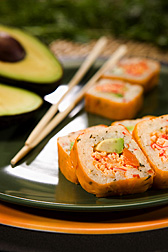This page has been archived and is being provided for reference purposes only. The page is no longer being updated, and therefore, links on the page may be invalid.
Read the magazine story to find out more. |
|
|
Flavorful Fruit and Veggie Wraps Inspire Tasty Creations
By Marcia WoodAugust 10, 2009
Colorful, paper-thin sheets of edible fruit and vegetable wraps add elegance and appeal to appetizers, entrées, desserts–and more. Chefs and home cooks love these versatile wraps, whether their choice is mango, strawberry, tomato-basil, or perhaps carrot-ginger or red bell pepper. That's according to Agricultural Research Service (ARS) research leader Tara H. McHugh.
Made from fruit and veggie purées and other natural ingredients, the wraps and a related product--meltable sheets that form flavorful glazes--are strong yet pliable, which makes them easy and fun to work with. For example, sheets of the rich-red strawberry wrap can be cut into squares, then rolled to form cones to fill with black seedless grapes, sliced strawberries, and pineapple chunks for individual servings of fresh-fruit salad. A drop of honey keeps the cone from unrolling.
Wraps and glazes have a role with entrées, too. The apple-honey-maple glaze, for example, provides a pleasing blend of flavors for the spiral-sliced hams sold by a major supermarket chain.
McHugh and food technologist Carl Olsen, both with the ARS Western Regional Research Center in Albany, Calif., and entrepreneur Matthew de Bord, founder of Origami Foods, LLC, Stockton, Calif., are co-inventors of the patent-pending process that Origami now uses for making these wraps and glazes. The team collaborated under terms of a Cooperative Research and Development Agreement.
All of Origami's wraps contain at least 75 to 90 percent fruit or vegetables, and are low in calories, low in fat, and free of additives, preservatives, or artificial flavors or colors.
The wraps may help introduce kids to the many flavors of fruits and vegetables. Right now, most Americans don't get the recommended number of daily servings of fruits and veggies.
Read more about the research in the August 2009 issue of Agricultural Research magazine.
ARS is the U.S. Department of Agriculture's principal intramural scientific research agency.

